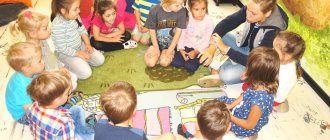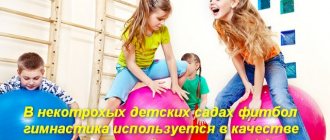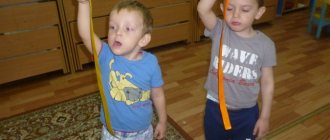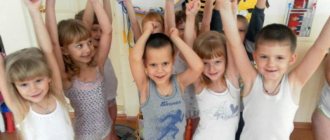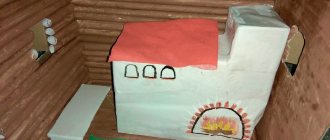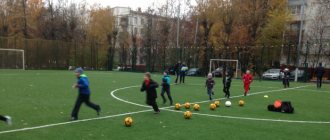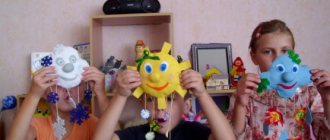What is breathing exercises?
Breathing exercises are a set of exercises aimed at developing and strengthening the body’s respiratory system. Prescribed for therapeutic and prophylactic purposes. Gymnastics is widely used as part of complex therapy in the treatment of diseases, as well as for general health improvement in children of preschool and school age.
Breathing exercises help prevent colds and bronchitis, recover from pneumonia and strengthen the child’s immunity. Developing the respiratory system increases the body's endurance during physical activity and improves brain function.
With regular exercise, lung volume increases and the respiratory muscles are strengthened. People suffering from bronchial asthma experience a reduction in the frequency of attacks.
REFERENCE! Breathing exercises saturate the child’s brain cells with oxygen - this helps him remember information better and participate more actively in the learning process.
Gymnastics on the street while walking
An excellent solution is to do breathing exercises for children while walking. In the open air, the lungs are better saturated with oxygen than in enclosed spaces. Exercises outdoors should be done in warm weather so that the child does not catch a cold.
Examples:
- "Cold". Legs apart, arms to the sides. Quickly cross your arms in front of you, clapping your palms on your shoulders and saying “uh,” and then move them back.
- "Who is taller" . As you inhale, rise onto your toes, arms up. Stretch as high as possible. As you exhale, stand on your full foot, arms down.
Recommendations for conducting
In kindergartens, breathing exercises are performed daily once or twice a day. The right time to do it is a morning walk and the period after the end of the “quiet hour”. At school - in physical education classes.
Basic recommendations for all age groups:
- Breathing exercises invigorate the body, so it is not advisable to do them before bed.
- Exercising on an empty stomach can be dangerous and can cause dizziness. At the same time, it is also not worth doing gymnastics immediately after eating in order to avoid digestive problems. The optimal time is an hour after eating.
- Gymnastics must take place in the fresh air. If it is not possible to go outside, the room must be well ventilated.
- There should be no dust in the room where classes are held that children will inhale.
- It is advisable that clothing be loose and not compress the chest and abdomen.
- For children aged two to three years, a complex of one to three lessons , lasting no more than 10 minutes, . Due to their age, they will not be able to practice for longer and may become distracted soon after they begin.
- To attract preschoolers to perform, gymnastics should be carried out in the form of a game. You can also invite children to smell flowers or guess what smell appeared in the air.
- The body should be relaxed during exercise, the muscles of the neck, arms and chest should not be tense.
- When inhaling and exhaling, the cheeks should not puff up (the exception is play exercises for younger children). This can be observed by placing your hands on them.
IMPORTANT! Breathing exercises have contraindications. Exercises are prohibited for persons suffering from heart disease and during acute inflammatory lung diseases and viral infections.
Safety precautions
Any, even the most useful things, can become harmful if not observed in moderation. Below are recommendations for the timing of breathing exercises or the approximate number of repetitions. But since all children are different, differing in their psychophysical characteristics, it is never enough to simply follow the instructions.
The main thing is that in no case should you force a child or force him to do exercises through “I can’t.”
This will not only discourage the baby from any desire for further activities, but can also harm his health. Even if you seem to have just started, but the child refuses to do the proposed exercise, do not insist. Try moving on to something else or postpone classes altogether if none of the exercises “work.”
Of course, this could just be a whim. A sensitive parent or educator will be able to determine what the problem is based on the specific situation. I just want to warn you that in the case of breathing exercises, any coercion or forcing is fraught, and a child’s refusal may be associated with some kind of physical problem, discomfort, which he cannot express or even understand.
Meanwhile, the rule is valid for both children and adults: all breathing exercises are performed only in an absolutely comfortable mode.
You can also encounter the opposite problem: when a child, having played too much, does not notice the discomfort and “excess.” Therefore, the adult’s task is to monitor external signs of the baby’s well-being. Pay close attention to the color of his face. If you become pale or severely red, it is better to stop exercising.
Moderate blush is a healthy natural effect and should not be intimidating. Some increased breathing is also normal, but you need to make sure that it is not excessive, take breaks, and alternate more active activities with calmer ones. If your child complains of dizziness, you should also pause and wait until it stops. Usually this happens quite quickly. Moderate dizziness, which soon subsides, is also a reaction within normal limits.
All of the above fully applies to those groups of children for whom breathing exercises are usually considered contraindicated: children with disorders of the cervical spine and some other health problems. None of these are actually contraindications. But classes with such children require special care, and it is better to entrust them to specialists.
Exercises for children of different ages
The set of exercises for children of different ages is different. It will be easier for preschoolers to complete activities in a playful way; they need to be involved in the process and interested. Older children can approach gymnastics more consciously - exercises can be done in a calm environment, listening to their body.
Preschool
- “Balloon” Stand with your legs apart and imagine an invisible balloon in your hands. When an adult counts “one, two,” take a deep breath, drawing air into your lungs. On the count of “three, four,” exhale forcefully, filling an imaginary ball. At the same time, show with your hands how the ball increases in size.
- “Hippopotamus” Children sit or lie down, put their hand on their stomach and breathe deeply. An adult says the words: “The hippos sat down and touched their bellies. The tummies swell (inhalation occurs), and then the tummies deflate (exhale).”
- “Birds” Children walk slowly, imitating the movement of a bird’s wings with their hands. When you swing up, you inhale, when you lower your arms, you exhale. At the same time, the adult accompanies the game with the phrases: “The birds are flying south,” “The birds are flapping their wings, lowering their wings.”
- “Soap bubble” Children stand in a circle, holding hands. They must inflate a huge soap bubble, the boundaries of which they themselves have become. Inhale deeply through the nose and exhale forcefully. The imaginary bubble between the children is inflated, and with each exhalation they take a step back. The adult encourages: “Blow up a bubble, blow up big! Don’t burst!” When the children have moved as far as possible from each other, the leader claps his hands and shouts: “The bubble has burst!” Children scatter in different directions (small bubbles fly away).
- “Diving under water” The child must imagine that he has to swim under water. To do this, he takes a deep breath, then holds his breath for the maximum amount of time. In this case, you can hold your nose with your hand or imitate swimming by slowly spreading your arms
REFERENCE! It is very useful to blow soap bubbles and balloons, blow on dandelions and feathers. This promotes the development of fine output regulation.
School
- “Breathing with one nostril” A very useful exercise for improving brain function. Stand up straight, body relaxed. Close your left nostril with your finger and take a deep, long breath. Open your nostril and close your right one, exhale slowly. Then do it in reverse order and repeat 5-6 times.
- “Deep cleansing” Carry out in any comfortable position - sitting, lying or standing. First, exhale as much air as possible from your lungs, then inhale slowly and deeply, protruding your chest forward and trying to squeeze your shoulder blades together. Take three sharp, strong exhalations through closed lips. Repeat the exercise 3 times.
- “Breathing restoration” Basic exercise after physical activity. The child inhales air through the nose, filling the lungs as much as possible. Holds your breath for a few seconds and exhales slowly through your mouth. The exercise is repeated until calm breathing is completely restored.
- “Strengthening the lungs” Stand up straight, arms extended in front of you, clench your fists. Slowly inhale deeply and hold your breath. Make three quick movements, spreading your arms as far as possible to the sides and behind your back and returning them back to the starting position. After this, exhale forcefully.
- “Class for athletes” Take an emphasis position lying on a gymnastic bench. Inhale slowly through your nose and hold your breath. Slowly move your body into a high plank position, resting only on your palms and toes. Return to the starting position and slowly exhale all the air from your lungs.
REFERENCE! Classes with schoolchildren, starting from the first grade, are held for 10-30 minutes.
Gymnastics according to A. N. Strelnikova for children from 4 years old
Alexandra Nikolaevna Strelnikova – teacher-vocalist. When she became seriously ill, she suffered an attack of suffocation, and acting gymnastics helped her. Her entire technique is based precisely on this gymnastics. Subsequently, the teacher began to help people strengthen their bodies, and help patients recover from various ailments.
In preschool educational institutions, Strelnikova’s breathing exercises have become widespread; her catalog of exercises includes many different techniques and techniques that allow children to fight colds and perfectly strengthen the immune system.
The complex should be performed following several rules:
- The most important aspect of gymnastics is inhaling through the nose (it is noisy and sharp).
- You need to exhale through your mouth, calmly and smoothly.
- Each specific movement is accompanied by an inhalation.
- Each exercise has a specific, clear rhythm. It is comparable to a drill march.
Exercise “Palms” or “Fists”
This exercise is a warm-up exercise.
- The child is in the most comfortable position for him.
- The child bends his arms at the elbows, palms facing forward.
- At the command of the leader, the child inhales and at the same time clenches his hands into fists.
- This is followed by a short pause (about 5 seconds), then repeating all actions several times.
If dizziness occurs, you should relax, sit down, and increase the pause time.
"Pogonchiki" or "Driver"
The child's hands are clenched into fists and placed in the middle of the abdomen. At the same time, you should pay attention that the rest of the body should not be tense (especially the shoulders). With a rapid inhalation, the child sharply pushes his fully straightened arms towards the floor. Afterwards the child returns to the starting position. 8 times is the recommended amount to perform.
"Pump" or "Pump"
The exercise is performed standing. Legs slightly apart. At the command of the leader, the child makes a slight tilt, and in the second half inhales sharply through the nose. The inhalation ends with the bend. After this, the child needs to rise slightly and perform the tilting movement again.
We should not forget that each exercise is performed in the rhythm of a marching step. The manager needs to monitor the rounded back of the wards, as well as the level of inclination - it should not be too low. This exercise should be performed 12 times.
"Hug your shoulders" or "Hug yourself"
During this exercise, the child seems to hug himself with bent arms. Raising them to shoulder level, he inhales sharply and hugs himself. 12 times is the amount recommended for performing the exercise.
The manager needs to find out whether there are children with heart defects and coronary heart disease. The exercise should not be performed with such a disease.
"Kitty"
In a standing position, the child begins to perform dance squats. The turn to the right is accompanied by a short inhalation, and at this moment the hands make grasping movements. The same goes for turning to the left.
Repeat 12 times. The leader pays attention to light, springy squats and relaxed, voluntary exhalation. During squats, your feet do not need to be lifted off the floor; all actions are performed with a straight back.
"Head turns"
The content of this exercise includes turning your head. The neck is relaxed at this moment, and each turn is accompanied by an inhalation.
Repeat the exercise 12 times.
Hatha yoga gymnastics for children over 5 years old
To introduce children to a healthy lifestyle, many teachers use such modern techniques as hatha yoga. Its implementation makes it possible to improve the physical and mental abilities of children and instill in them a culture of health.
Breathing exercises, which have an extensive catalogue, together with a rational regimen, proper nutrition and hardening in kindergarten, give excellent results.
More specifically:
- The number of children suffering from acute respiratory infections and influenza is decreasing.
- Children experience an increase in vitality.
- Memory and physical development improves.
- Children cope better with mastering the program.
- Increases communication skills and endurance.
Exercise "Snake"
Children sit in a comfortable position. The right hand closes the left nostril, and inhalation occurs through the right.
Then the right nostril is closed and exhalation occurs through the left. The teacher needs to use various imitation techniques: a breeze, a hurricane, inflating a balloon.
"Divers"
The teacher uses a game situation: children imagine that they are brave divers who dive in search of sunken ships. It is necessary to find suitable pictures, video clips and entertaining stories. This exercise teaches children to hold their breath. Needs to be repeated several times.
"Ball"
Starting position – lying down. The teacher asks the children to focus on breathing and take a deep breath, inflating their chest “like a balloon.”
This exercise helps children get used to breathing through their diaphragm.
"Wind"
The teacher asks the children to imagine that a warm summer breeze flew through their window. Children take a deep breath through their nose and exhale with the sound “U”. Then the teacher says that a cold wind has blown, the children inhale through their noses, and as they exhale, close their teeth tightly and say “Aah.”
